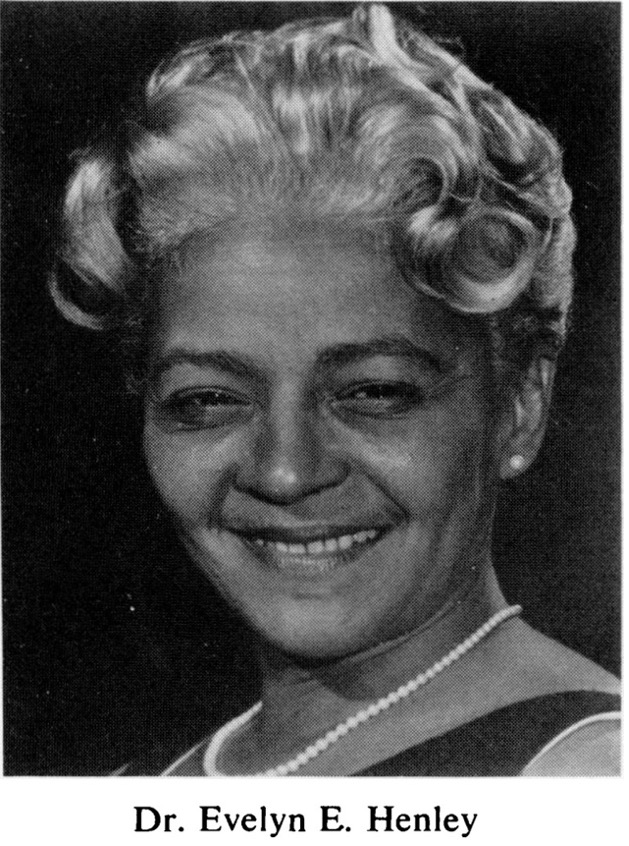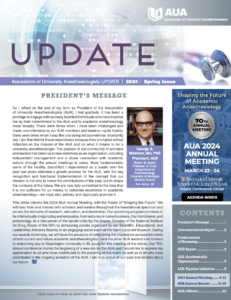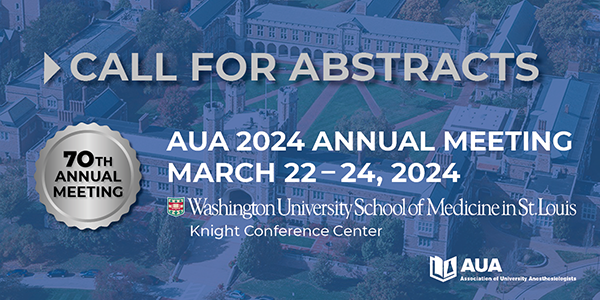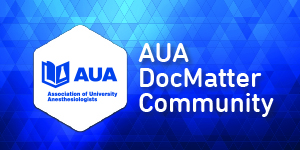AUA Visits NMA: A Timely First
It gives me great pleasure, as a member of the Association of University of Anesthesiologists (AUA) Leadership Advisory Board, to announce that the AUA will have a presence at the annual meeting of the National Medical Association (NMA) in Atlanta, GA from July 30 – August 3, 2022. A few members of the AUA are also members of the NMA. Nearly every year since its founding in 1895, the NMA has held the Annual Convention & Scientific Assembly, which is regarded as the nation's foremost forum on medical science and African American health. The NMA is accredited by the Accreditation Council for Continuing Medical Education to sponsor continuing medical education (CME). (1)
Through the presentation of CME programs at the national and regional conventions as well as at state and local society meetings, NMA members can meet Category 1 requirements for the Physician's Achievement Award of the NMA and the Physician's Recognition Award of the American Medical Association (AMA).(1) The NMA offers CME programs in 23 specialties; from aerospace medicine to urology. The current president of the NMA is Rachel Villanueva, MD. The NMA has not shied away from issues of social concern. The statement calling for Common Sense Comprehensive Gun Reform after another mass shooting of black people in Buffalo, NY was posted on their website on May 16, 2022. (2)
The NMA is the largest and oldest national organization representing African American physicians, dentists, other health professionals and their patients in the United States since its inception in 1895. The NMA is a 501(c)(3) national professional and scientific organization representing the interests of more than 30,000 African American physicians and the patients they serve, with nearly 129 affiliated societies throughout the nation and U.S. territories. The NMA is committed to improving the quality of health among minorities and vulnerable populations through its membership, professional development, community health education, advocacy, research, and partnerships with federal and private agencies. Throughout its history the NMA has focused primarily on health issues related to African Americans and medically underserved populations; however, its principles, goals, initiatives, and philosophy encompass all ethnic groups. The National Medical Association has firmly established its leadership role in medicine. The importance of inclusiveness within the NMA was stated by one of its founding members and it is represented in the following quotation:
“Conceived in no spirit of racial exclusiveness, fostering no ethnic antagonism, but born of the exigencies of the American environment, the National Medical Association has for its object the banding together for mutual cooperation and helpfulness, the men and women of African descent who are legally and honorably engaged in the practice of the cognate professions of medicine, surgery, pharmacy and dentistry."
— C.V. Roman, M.D. NMA Founding Member and First Editor of the Journal of the National Medical Association (NMA) 1908.(3)
The exigent circumstances at the time related to the Jim Crow era in the United States whereby state laws and social customs mandated the racial segregation of medical societies, medical facilities, and medical education. (4,5) The NMA was organized by twelve black doctors attending the Cotton States and International Exposition in Atlanta, Georgia. The first president was Dr. Robert F. Boyd, and Dr. Daniel Hale Williams served as the vice president. (1) I encourage the readers of this article to delve into the biographies of Dr. Boyd, who was born an enslaved child in the American South and Dr. Daniel Hale Williams, who founded the first integrated hospital in the U.S. (Provident in Chicago, IL) among many other achievements.
To give additional historical perspective in 2005, the Institute of Ethics of the American Medical Association (AMA) commissioned an independent panel, the Writing Group on the History of African Americans, and Organized Medicine, to analyze the AMA’s history on issues of race. (6)
The Writing Group’s research clearly documented the AMA’s role in creating structural racism, defined as “a system in which public policies, institutional practices, cultural representations, and other norms work in various, often reinforcing ways to perpetuate racial group inequity.” (3) After the research group reported back to AMA’s Board of Trustees, in July 2008, immediate past President, Dr. Ronald Davis issued a formal public apology to the NMA. The speech by Dr. Davis included the following:
“I humbly come to the physicians of today’s National Medical Association to tell you that we are sorry…on behalf of the American Medical Association, I unequivocally apologize for our past behavior. We pledge to do everything in our power to right the wrongs that were done by our organization to African-American physicians and their families and their patients.”(6) It is important to note that the AMA also supported activities against other ethnic minorities, most notably the Asian Exclusion Act Of 1924. This act was not only anti-immigration but prevented citizenship to Asian people living in the US until the mid-twentieth century. (7)
The Anesthesiology Section of the NMA
The Evelyn E. Henley Anesthesia Society (EEHAS) was established in 2015 by a group of physicians who were concerned and committed to highlight the contribution of anesthesiologists to healthcare delivery in the United States. The EEHAS strives to be a leading authority for physicians and patients and issues that impact the practice of and access to inclusive pain management and anesthesia care in all populations, including advocacy for initiatives and programs focused on education and treatment modalities. The EEHAS is focused on building strong, effective relationships with varied stakeholders throughout the healthcare community to advance its advocacy agenda. The current president of the EEHAS is Bryant Murphy, MD.
Dr. Evelyn Henley’s history
Evelyn Elnora Henley, MD (August 25, 1913 – August 28, 1976) was the first Black woman to be certified as Diplomat of the American Board of Anesthesiology and a Fellow of the American College of Anesthesiologists in 1960. (Fig. 1). She subsequently served as Chief of Anesthesiology at Howard University College of Medicine. Dr Henley started her career as a practicing nurse anesthetist who decided to go to medical school and become an anesthesiologist. She graduated from Howard University College of Medicine in 1954 with honors and completed her residency in Anesthesiology at DC General Hospital in 1958. Subsequently, she served as Chief of Anesthesiology at Howard University College of Medicine. Dr Henley was the first minority female to chair the Anesthesiology Department at Boston University. (8,9)
The EEHAS has a packed agenda for its portion of the annual NMA meeting including lectures and workshops. The airway and point of care ultrasound workshops for regional and regional anesthesia with live models are popular every year. In addition, as is the custom for this meeting, there will be representatives from leadership from every major anesthesiology organization including American Board of Anesthesiology, American Society of Anesthesiologists and AUA. It is during these sessions that mutual feedback is given regarding pressing issues and concerns from each organization on behalf of their members. More information can be found about the EEHAS at www.henleysociety.com.
Vivian Abalama, AUA Director, and I will be staffing the AUA exhibit at the EEHAS meeting & the NMA 2022 national meeting. If you plan to attend, please stop by. Registration for the 2022 annual NMA meeting can be accessed using the final reference for this article. (10)
References:
- Information on the National Medical Association from its founding to current activities. https://en.wikipedia.org/wiki/National_Medical_Association. Last updated February 23, 2022. Accessed May 20, 2022
- NMA calls for comprehensive gun reform from its website. https://www.nmanet.org/news/605591/The-National-Medical-Association-Calls-for-Comprehensive-Common-Sense-Gun-Reform.htm. Posted May 16, 2022. Accessed May 20, 2022.
- National Medical Association posts historical and current Mission Statements. https://www.nmanet.org/page/Mission. Published October 16, 1999. Accessed May 19, 2022.
- Ward TJ, Black Physicians in the Jim Crow South.1st ed. Fayetteville: University of Arkansas Press; 2003:156.
- Morrison, Sheena M.; Fee, Elizabeth (2010-04-01). "The Journal of the National Medical Association: A Voice for Civil Rights and Social Justice". American Journal of Public Health. 100 (S1): S70–S71
- Baker R, Wynia MK. Living Histories of Structural Racism and Organized Medicine. AMA J Ethics. 2021 Dec 1;23(12):E995-1003.
- Library of Congress site chronicles Chinese exclusion act of 1882. https://www.loc.gov/classroom-materials/immigration/chinese/exclusion. Published December 17, 2020. Accessed May 19, 2022.
- Francis J, Joseph V. Minority Women in Anesthesiology. Int Anesthesiol Clin. 2018 Summer;56(3):74-95.
- Evelyn Elnora Henley. J Natl Med Assoc. 1976 Nov;68(6):545.
- National Medical Association 2022 annual meeting registration information. https://www.mcisemi.com/nma2022/memberLookup.cfm. Published February 2, 2022. Accessed 5-20, 2022.
Figure legend:
Figure 1. Dr. Evelyn E. Henley
Figure 1:

Source: Dr. Evelyn Elnora Henley. J Natl Med Assoc. 1976 Nov;68(6):545.











